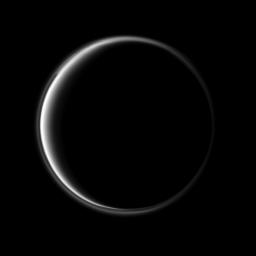
|
Light on the Dark Side
- Click the image above for a larger view
- Full-Res JPEG (960 x 960) (19.1 kB)
- Full-Res TIFF (960 x 960) (922.8 kB)
Caption:
Sunlight scattering through the periphery of Titan's atmosphere reaches Cassini as the spacecraft's camera is pointed at the dark side of the moon.
A detached, high-altitude global haze layer encircles the moon. See PIA07774 to see an enhanced-color view and learn more about why the detached haze layer is best studied in the ultraviolet. This view looks toward the leading hemisphere of Titan (5,150 kilometers, or 3,200 miles across). North on Titan is up.
The image was taken with the Cassini spacecraft narrow-angle camera on April 2, 2010 using a spectral filter sensitive to wavelengths of ultraviolet light centered at 338 nanometers. The view was acquired at a distance of approximately 1.5 million kilometers (932,000 miles) from Titan and at a Sun-Titan-spacecraft, or phase, angle of 153 degrees. Image scale is 9 kilometers (6 miles) per pixel.
Background Info:
The Cassini-Huygens mission is a cooperative project of NASA, the European Space Agency and the Italian Space Agency. The Jet Propulsion Laboratory, a division of the California Institute of Technology in Pasadena, manages the mission for NASA's Science Mission Directorate, Washington, D.C. The Cassini orbiter and its two onboard cameras were designed, developed and assembled at JPL. The imaging operations center is based at the Space Science Institute in Boulder, Colo.
For more information about the Cassini-Huygens mission visit http://saturn.jpl.nasa.gov/ . The Cassini imaging team homepage is at http://ciclops.org .
Cataloging Keywords:
| Name | Value | Additional Values |
|---|---|---|
| Target | Titan | |
| System | Saturn | |
| Target Type | Satellite | |
| Mission | Cassini-Huygens | |
| Instrument Host | Cassini Orbiter | |
| Host Type | Orbiter | |
| Instrument | Imaging Science Subsystem (ISS) | |
| Detector | Narrow Angle Camera | |
| Extra Keywords | Atmosphere, Grayscale, Haze, Ultraviolet, Visual | |
| Acquisition Date | ||
| Release Date | 2010-06-28 | |
| Date in Caption | 2010-04-02 | |
| Image Credit | NASA/JPL/Space Science Institute | |
| Source | photojournal.jpl.nasa.gov/catalog/PIA12664 | |
| Identifier | PIA12664 | |
